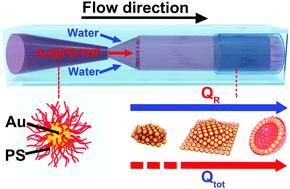当前位置:
X-MOL 学术
›
Mater. Chem. Front.
›
论文详情
Our official English website, www.x-mol.net, welcomes your feedback! (Note: you will need to create a separate account there.)
Flow hydrodynamics-dependent assembly of polymer-tethered gold nanoparticles in microfluidic channels
Materials Chemistry Frontiers ( IF 7 ) Pub Date : 2020-08-25 , DOI: 10.1039/d0qm00456a Xi Mao 1, 2, 3 , Zhengping Tan 1, 2, 3 , Wei Lan 3, 4, 5 , Huayang Wang 1, 2, 3 , Haiying Tan 2, 3, 6 , Fan Li 1, 2, 3 , Ke Wang 1, 2, 3 , Ming Wu 1, 2, 3 , Xiaobing Luo 3, 4, 5 , Lianbin Zhang 1, 2, 3 , Jiangping Xu 1, 2, 3 , Jintao Zhu 1, 2, 3
Materials Chemistry Frontiers ( IF 7 ) Pub Date : 2020-08-25 , DOI: 10.1039/d0qm00456a Xi Mao 1, 2, 3 , Zhengping Tan 1, 2, 3 , Wei Lan 3, 4, 5 , Huayang Wang 1, 2, 3 , Haiying Tan 2, 3, 6 , Fan Li 1, 2, 3 , Ke Wang 1, 2, 3 , Ming Wu 1, 2, 3 , Xiaobing Luo 3, 4, 5 , Lianbin Zhang 1, 2, 3 , Jiangping Xu 1, 2, 3 , Jintao Zhu 1, 2, 3
Affiliation

|
Recently, self-assembly of polymer-tethered inorganic nanoparticles (NPs) in microfluidic chips has been employed as an effective approach to fabricate novel assemblies. Herein, we systematically studied the self-assembly of polystyrene-grafted gold NPs (AuNP@PS) in microfluidic chips into various structures by changing the organic/aqueous flow rate ratio (RQ), the total flow rate (Qtot), the molecular weight of PS ligands (Mn), and the radius of the AuNP core (r0). Morphological transitions of the assemblies were demostrated to be dependent on the hydrodynamic conditions, i.e., RQ and Qtot. We then employed the effective softness (λeff) to describe the structural features of AuNP@PS and the formation of assemblies. The results indicated that the morphology of the AuNP@PS assemblies was affected by λeff. When λeff ≤ 2.96, lamellar structures (e.g., nanosheets and bowl-like assemblies) were captured by varying RQ and Qtot. When λeff > 2.96, only spherical assemblies were obtained with the increase of RQ and Qtot. We further found that the AuNP@PS assemblies showed an excellent photothermal conversion performance. These findings not only demonstrate the kinetics dependent assembly behavior of polymer-tethered NPs in microfluidic chips, but also provide a convenient way to prepare NP assemblies with well-ordered structures, potentially useful in drug delivery, photothermal therapy, and others.
中文翻译:

聚合物束缚的金纳米颗粒在微流体通道中的流动流体动力学依赖性组装
近年来,聚合物束缚的无机纳米粒子(NPs)在微流控芯片中的自组装已被用作制造新型组件的有效方法。在这里,我们通过改变有机/水流量比(R Q),总流量(Q tot),水的流量,系统地研究了微流体芯片中聚苯乙烯接枝的金纳米颗粒(AuNP @ PS)的自组装成各种结构。PS配体的分子量(M n)和AuNP核的半径(r 0)。所述组件的形态跃迁实例阐述依赖于流体动力学条件,即,- [R Q和Q TOT。然后,我们所用的有效的柔软性(λ EFF)来描述的AuNP的@ PS的结构特征和组件的形成。结果表明,所述的AuNP @ PS组件的形态受λ EFF。当λ EFF ≤2.96,层状结构(例如,纳米片和碗状组件),通过改变捕获- [R Q和Q TOT。当λ EFF > 2.96,用的增加仅获得球形组件- [R Q和Q TOT。我们进一步发现,AuNP @ PS组件表现出出色的光热转换性能。这些发现不仅证明了聚合物束缚的NP在微流控芯片中的动力学依赖性组装行为,而且还提供了一种方便的方法来制备结构整齐的NP组装,可能在药物输送,光热疗法等方面有用。
更新日期:2020-09-16
中文翻译:

聚合物束缚的金纳米颗粒在微流体通道中的流动流体动力学依赖性组装
近年来,聚合物束缚的无机纳米粒子(NPs)在微流控芯片中的自组装已被用作制造新型组件的有效方法。在这里,我们通过改变有机/水流量比(R Q),总流量(Q tot),水的流量,系统地研究了微流体芯片中聚苯乙烯接枝的金纳米颗粒(AuNP @ PS)的自组装成各种结构。PS配体的分子量(M n)和AuNP核的半径(r 0)。所述组件的形态跃迁实例阐述依赖于流体动力学条件,即,- [R Q和Q TOT。然后,我们所用的有效的柔软性(λ EFF)来描述的AuNP的@ PS的结构特征和组件的形成。结果表明,所述的AuNP @ PS组件的形态受λ EFF。当λ EFF ≤2.96,层状结构(例如,纳米片和碗状组件),通过改变捕获- [R Q和Q TOT。当λ EFF > 2.96,用的增加仅获得球形组件- [R Q和Q TOT。我们进一步发现,AuNP @ PS组件表现出出色的光热转换性能。这些发现不仅证明了聚合物束缚的NP在微流控芯片中的动力学依赖性组装行为,而且还提供了一种方便的方法来制备结构整齐的NP组装,可能在药物输送,光热疗法等方面有用。


























 京公网安备 11010802027423号
京公网安备 11010802027423号